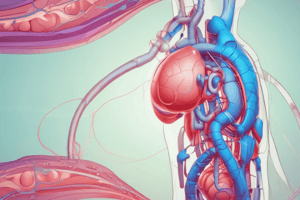Podcast
Questions and Answers
Which components are involved in oxygenation? (Select all that apply)
Which components are involved in oxygenation? (Select all that apply)
- Heart (correct)
- Nerves
- Lungs (correct)
- Red Blood Cells (correct)
What is the normal pumping rate of the heart?
What is the normal pumping rate of the heart?
5L/min
Match the following layers of cardiac muscle tissue with their descriptions:
Match the following layers of cardiac muscle tissue with their descriptions:
Epicardium = Outermost layer Myocardium = Middle layer Endocardium = Innermost layer
The heart has four main chambers.
The heart has four main chambers.
What are the two main types of heart valves?
What are the two main types of heart valves?
What is the term for the volume of blood distending the ventricles at the end of diastole?
What is the term for the volume of blood distending the ventricles at the end of diastole?
The SA node initiates impulses at a rate of 40-60 beats per minute.
The SA node initiates impulses at a rate of 40-60 beats per minute.
Which of the following is NOT a function of the vascular system?
Which of the following is NOT a function of the vascular system?
What does SV stand for in cardiac output?
What does SV stand for in cardiac output?
Which of the following are considered modifiable risk factors for cardiovascular disease? (Select all that apply)
Which of the following are considered modifiable risk factors for cardiovascular disease? (Select all that apply)
Study Notes
Components of Oxygenation
- Key components: heart, lungs, red blood cells, blood vessels.
Anatomy and Physiology of the Heart
- The heart is a cone-shaped, hollow muscular organ in the mediastinum, between the lungs.
- Pumps approximately 60 ml per beat, equating to about 5 liters per minute.
- Surrounded by the pericardium, which acts as a protective covering.
Cardiac Muscle Layers
- Epicardium: Outermost layer of cardiac muscle.
- Myocardium: Middle layer; the heart's major muscular part.
- Endocardium: Innermost layer lining the heart chambers.
Heart Chambers and Pressures
- Right Atrium: Normal pressure ranges from 0-5 mmHg; receives blood from the superior vena cava (SVC), inferior vena cava (IVC), and coronary sinus.
- Right Ventricle: Normal pressure around 25 mmHg; pumps blood to the lungs.
- Left Atrium: Receives oxygenated blood from the lungs.
- Left Ventricle: Responsible for pumping oxygenated blood to the body.
Heart Valves
- Atrioventricular (AV) valves separate atria from ventricles.
- Semilunar valves control blood flow into arteries.
Coronary Arteries
- Left Coronary Artery supplies blood to the left side of the heart, including the left anterior descending artery and circumflex artery.
- Right Coronary Artery supplies right atrium, right ventricle, and inferior portion of the left ventricle.
- Branching patterns of coronary arteries can vary significantly among individuals.
Electrophysiologic Properties
- Automaticity: Heart can initiate impulses spontaneously.
- Excitability: Heart's ability to respond to stimuli.
- Conductivity: Transmission of electrical impulses throughout the heart.
- Contractility: The heart’s ability to contract and pump blood.
- Refractoriness: Period during which the heart cannot respond to a stimulus until it repolarizes.
Heart Conduction System
- SA node generates 60-100 beats per minute.
- AV node functions at 40-60 beats per minute.
- Bundle of His, right and left bundle branches, and Purkinje fibers (20-40 beats per minute) facilitate impulse conduction.
Cardiac Cycle Events
- Systole: Phase of contraction where the heart empties.
- Diastole: Phase of relaxation where the heart fills with blood.
Mechanical Properties of the Heart
- Cardiac Output: Calculated as the product of heart rate (HR) and stroke volume (SV).
- Influenced by the autonomic nervous system, endogenous catecholamines, and medications.
- Stroke Volume components:
- Preload: Volume of blood in ventricles at end-diastole.
- Afterload: Resistance ventricles face when ejecting blood.
- Contractility: Strength of ventricular contraction.
Vascular System Functions
- Provides pathways for blood circulation to nourish body tissues.
- Carries waste products to excretory organs.
- Facilitates lymphatic flow to drain tissue fluids back into circulation.
- Returns blood to the heart for recirculation.
Assessment Techniques for Cardiovascular Health
- Patient history: Focuses on demographic data, family history, personal health, diet, and socioeconomic status.
- Modifiable risk factors include smoking, physical inactivity, obesity, psychological factors, and chronic diseases.
- Non-modifiable risk factors encompass age, gender, ethnicity, and family history.
Key Indicators of Cardiovascular Disease (CVD)
- Major symptoms:
- Pain or discomfort.
- Dyspnea, including dyspnea on exertion (DOE), orthopnea, and paroxysmal nocturnal dyspnea.
- Fatigue and palpitations.
- Weight gain indicating fluid retention (edema).
- Syncope, or transient loss of consciousness due to decreased cerebral perfusion.
Studying That Suits You
Use AI to generate personalized quizzes and flashcards to suit your learning preferences.
Related Documents
Description
Test your knowledge on the components involved in oxygenation, including the heart, lungs, red blood cells, and blood vessels. This quiz covers crucial aspects of the anatomy and physiology that facilitate effective oxygen transport in the body. Review the structure and function of these vital systems to improve your understanding.




